Flag of Afghanistan
The national flag of Afghanistan (Dari Persian: پرچم افغانستان,[1] Pashto: افغانستان توغ) consists of a vertical tricolor with the classical National Emblem in the center. The current flag was adopted on August 19, 2013, but many similar designs had been in use throughout most of the 20th century.
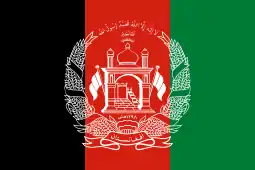 | |
| Use | National flag and ensign |
|---|---|
| Proportion | 2:3 |
| Adopted | August 19, 2013 |
| Design | Three vertical bands of black, red and green with the National Emblem in white centered on the red band and then slightly overlapping the black and green bands. |
Afghanistan has had 25 flags since the first flag when the Hotak dynasty was established in 1709. During the 20th century alone, Afghanistan went through 18 national flags, more than any other country during that time period,[2][3] and most of them had the colors black, red, and green on them. Along with Haiti, Bolivia, Costa Rica, the Dominican Republic, Ecuador, El Salvador, and Venezuela, it is one of eight national flags whose design incorporates a depiction of the flag itself.[4] It is also, along with Bolivia, Cambodia, Portugal, San Marino, and Spain, one of only six national flags that feature a building.[5]
Design and colors scheme
The black color represents its troubled 19th century history as a protected state, the red color represents the blood of those who fought for independence (specifically, the Anglo-Afghan Treaty of 1919), and the green represents hope and prosperity for the future.[6][7] Some have alternatively interpreted the black to represent history, the red to represent progress, and the green to represent either agricultural prosperity or Islam.[8][9]
.svg.png.webp)
.svg.png.webp)
The tricolor was supposedly inspired by the Afghan King, Amanullah Khan, when visiting Europe with his wife in 1928. The original horizontal tricolor design was based on that of the flag of Germany.[10]
The center of the flag contains the Emblem of Afghanistan. Almost every national flag since 1928 has had the emblem in the center. Almost every emblem has had a mosque in it, which first appeared in 1901, and wheat, first appearing in 1928.
The colors video approximation (valid for flags 1928-1978 and 1980–present) is listed below:
| Black | Red | Red | Green | Green | White | |
|---|---|---|---|---|---|---|
| RGB | 0/0/0 | 211/32/17 | 190/0/0 | 0/122/54 | 0/153/0 | 255/255/255 |
| Hex | #000000 | #d32011 | #be0000 | #007a36 | #009900 | #FFFFFF |
| CMYK | 0/0/0/100 | 0/85/92/17 | 0/100/100/25 | 100/0/56/52 | 100/0/100/40 | 0/0/0/0 |
Other flags
.svg.png.webp)
.svg.png.webp)
.svg.png.webp)
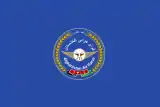 Flag of the Afghan Air Force
Flag of the Afghan Air Force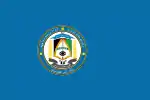 Flag of the Afghan National Police
Flag of the Afghan National Police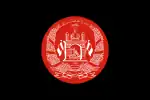 Standard of the President of Afghanistan (since 2013) – a black field with the large red disc in the center bearing the national emblem in white.
Standard of the President of Afghanistan (since 2013) – a black field with the large red disc in the center bearing the national emblem in white..svg.png.webp) Flag with a different ratio and emblem used during the Transitional period from 2002-2004 with some minor use today.
Flag with a different ratio and emblem used during the Transitional period from 2002-2004 with some minor use today.
Gallery of usage
 Flags of Afghanistan on Kote Sangi during Independence Day
Flags of Afghanistan on Kote Sangi during Independence Day The Afghan flag flying at the Presidential Palace compound (2019)
The Afghan flag flying at the Presidential Palace compound (2019) Afghan children with the national flag in Badghis Province
Afghan children with the national flag in Badghis Province Afghan children waving national flags in Helmand Province
Afghan children waving national flags in Helmand Province.jpg.webp) Afghan flag hanging over the Afghan Embassy in Bonn, Germany
Afghan flag hanging over the Afghan Embassy in Bonn, Germany Afghan flags during the handover of Lashkargah (2011)
Afghan flags during the handover of Lashkargah (2011) Afghan Border Police in Herat (2011)
Afghan Border Police in Herat (2011)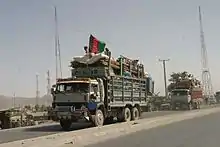 Afghan refugees returning from Pakistan with an Afghan tricolor flag on their truck (2004)
Afghan refugees returning from Pakistan with an Afghan tricolor flag on their truck (2004) Afghan, British and US flags on poles during a ceremony in Helmand Province (2010)
Afghan, British and US flags on poles during a ceremony in Helmand Province (2010)
Historical flags
| Flag | Years of use | Ratio | Government | Notes |
 |
1709–1738 | 2:3 | Hotak dynasty | Flag of Hotak dynasty. |
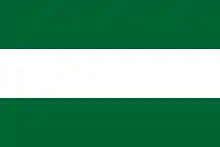 |
1747–1842 | 2:3 | Durrani Empire | Flag flown under the rule of Ahmad Shah Durrani and his dynasty. |
| No official flag during this period. | 1842–1880 | Emirate of Afghanistan | Prior to 1880, the Barakzai dynasty did not use the flag associated with the Durranis, or any official alternative. | |
.svg.png.webp) |
1880–1901 | 2:3 | Emirate of Afghanistan | Flag flown under the rule of Abdul Rahman Khan. |
.svg.png.webp) |
1901–1919 | 3:5 | Emirate of Afghanistan | State and war flag flown under the rule of Habibullah Khan. Habibullah added to his father's flag a seal that is the precursor of the modern-day seal, containing the mosque. |
.svg.png.webp) |
1919–1926/29 | 2:3 | Emirate of Afghanistan | First flag flown under the rule of King Amanullah. He expanded upon his father's flag by adding rays emanating from the seal in the form of an octagram. This new style of seal was common in the Ottoman Empire. Afghanistan became a kingdom in 1926. |
.svg.png.webp) |
1926–1928 | 2:3 | Kingdom of Afghanistan | Second flag flown under the rule of King Amanullah. He replaced the octagram with a wreath and slightly modified the national seal. This mosque design in this seal would be adopted for most of Afghanistan's flags in the future. The mosuq has a mihrab facing Mecca. |
.svg.png.webp) |
1928 | 3:5 | Kingdom of Afghanistan | Third flag flown under the rule of King Amanullah, introduced c. June 1928. The black, red, and green tricolor, respectively representing the past (previous flags), the bloodshed for independence (Third Anglo-Afghan War), and hope for the future, was probably influenced by Khan's visit abroad to Europe and especially Weimar Republic (black-red-gold) in 1927. |
.svg.png.webp) |
1928–1929 | 2:3 | Kingdom of Afghanistan | Fourth flag flown under the rule of King Amanullah, introduced c. July 1928. It was the first vertical-tricolored flag which would be used throughout most of the remainder of the 20th century and in the present day. The new seal shows the sun rising over two snow-capped mountains, representing a new beginning for the kingdom. This seal also contained heaps of wheat, an icon that would be present on all future emblems of Afghanistan throughout different regimes. Notably, only the Soviet emblem had wheat at the time, and would in the future appear on many communist states' flags. |
_(variant).svg.png.webp) |
1928–1929 | 2:3 | Kingdom of Afghanistan | A variant of the above flag with long thick sun rays, similar to the Japanese Rising Sun Flag, as well as a centered yellow star. |
.svg.png.webp) |
1929 | 2:3 | Kingdom of Afghanistan | A short-lived flag flown from January to October 1929. |
.svg.png.webp) |
1929 | 2:3 | Kingdom of Afghanistan | This flag (same as the original 1919) was reported to be flown under the short-lived rule of Inayatullah Khan.[11] |
.svg.png.webp) |
1929 | 2:3 | Emirate of Afghanistan (1929) | Flag flown under the brief rule of Habibullah Kalakani – a red, black, and white vertical tricolor, like the ones used by the Mongols during their occupation of Afghanistan in the 13th century.[12] |
 |
1929 | 2:3 | Kingdom of Afghanistan | During the rebellion of Kalakani, a similar flag was used in Herat in the rebellion of the Tajiks. |
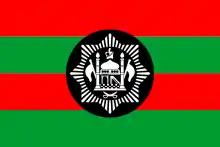 |
1929 | 2:3 | Kingdom of Afghanistan | Transitional Flag used by Ali Ahmad Khan's short-lived rival government in Jalalabad, in opposition to Kalakani. |
.svg.png.webp) |
1929 – March 27, 1930 | 2:3 | Kingdom of Afghanistan | First flag flown under the rule of Nader Shah. The black, red, and green tricolor was re-established; the octogram seal borrowed from the first flag of King Amanullah replaced the sun and mountains seal, but the black-red-green vertical design was restored. |
.svg.png.webp) |
March 27, 1930 – July 16, 1973 | 2:3 | Kingdom of Afghanistan | Second flag flown under the rule of Nader Shah, it was also used by his son, Zahir Shah. The octagram rays were removed, and the seal enlarged – the mosque design is the same as introduced in the 1926 flag. In between the mosque and the seal is the year ١٣٤٨ (1348 of the lunar Islamic calendar, or 1929 AD of the Gregorian calendar) the year Mohammed Nadir Shah's dynasty began. |
.svg.png.webp) |
July 17, 1973 – May 8, 1974 | 2:3 | Republic of Afghanistan | First flag flown for the Republic of Afghanistan. It is identical to the previous flag, except that the year ١٣٤٨ was removed as Zahir Shah's monarchy ended. |
.svg.png.webp) |
May 9, 1974 – April 26, 1978 | 2:3 | Republic of Afghanistan | Second flag flown for the Republic of Afghanistan. The same colors were used, but the meanings reinterpreted: black for the obscure past, red for blood shed for independence, and green for prosperity from agriculture. In the canton is a new seal, with a golden eagle with spread wings, a pulpit (minbar) on the eagle's chest (for a mosque), wheat surrounding the eagle, and the sun's rays above the eagle (for the new republic). |
.svg.png.webp) |
April 27, 1978 – October 18, 1978 | 2:3 | Democratic Republic of Afghanistan | When the republic's president Mohammad Daoud Khan was killed in a coup, the new regime under the People's Democratic Party of Afghanistan (PDPA) established a communist state. For a brief period of time, during the transition, the same flag design was kept, but no seal. A similar flag was used by the Junbish-e Milli party which controlled autonomous northern Afghanistan from 1992 to 1998. |
.svg.png.webp) |
October 19, 1978 – April 21, 1980 | 1:2 | Democratic Republic of Afghanistan | A radical change, this flag used a red field with a yellow seal in the canton, a common design for socialist states in the 20th century. It consisted of the PDPA's Khalq faction's emblem with wheat, a star at the top (representing the five ethnic groups of the nation), the term 'Khalq' in Arabic script in the center, and a subtitle reading 'Saur Revolution ١٣٥٧' and the full name of the state. |
.svg.png.webp) |
1980 | 1:2 | Democratic Republic of Afghanistan | After the overthrow of the Khalq faction by the Parcham faction during the Soviet invasion, the flag of the People's Democratic Party, featuring a cogwheel representing industry and an ear of wheat to represent agriculture, was additionally used as a National flag. |
.svg.png.webp) |
April 22, 1980 – November 29, 1987 | 1:2 | Democratic Republic of Afghanistan | Under the Fundamental Principles program of the new leadership under Babrak Karmal, the traditional black, red, and green tricolor was re-established, representing the past, blood shed for independence, and the Islamic faith, respectively. A new seal was designed, with a rising sun (a reference to the former name, Khorasan, meaning "Land of the Rising Sun"), a pulpit and a book (considered to be the Communist Manifesto or Capital by Karl Marx ), ribbons with the national colors, a cogwheel for industry, and a red star for communism. The seal's ribbons and wheat has similarities to the then- East German and Romanian seals. |
.svg.png.webp) |
November 30, 1987 – April 26, 1992 | 1:2 | Republic of Afghanistan | The flag was changed as part of Mohammad Najibullah's National Reconciliation constitution changes. Same as the previous flag, except that in the national seal, the cogwheel is moved from the top to the bottom, the red star and the book are removed, and the green field curved to resemble the horizon. |
.svg.png.webp) |
April 27, 1992 − December 6, 1992 | 1:2 | Islamic State of Afghanistan | This flag was used as a provisional flag after the fall of the Najibullah pro-Soviet regime. It appeared in many variants of which one is shown here. In the upper stripe is Arabic Allahu Akbar, ("God is the greatest"); the center stripe contains the Shahadah. |
.svg.png.webp) |
April 27, 1992 − December 6, 1992 | 1:2 | Islamic State of Afghanistan | This flag was used as another provisional flag after the fall of the Najibullah pro-Soviet regime, lacking an emblem. |
.svg.png.webp) |
December 7, 1992 – November 12, 2001 | 1:2 | Islamic State of Afghanistan / Northern Alliance (de jure) | The new Islamic government under Rabbani featured a flag change. The color scheme is similar to several Middle Eastern Muslim nations' flags. The emblem is the same as the monarchy-era emblem, but with the addition of the Shahadah and swords representing the mujahideen's victory. It now shows the year ١۲۹٨ (1298), the solar Islamic calendar equivalent of AD 1919 of the Gregorian Calendar, the year of full independence. On the bottom part of the emblem was written "دا افغانستان اسلامی دولت", Islamic State of Afghanistan. |
.svg.png.webp) |
September 27, 1996 – October 26, 1997 | 2:3 | Islamic Emirate of Afghanistan | A plain white flag was flown by the Taliban. |
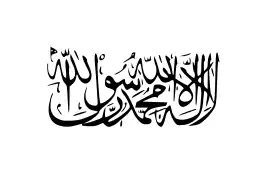 |
October 27, 1997 – November 12, 2001 | 2:3 | Islamic Emirate of Afghanistan | In 1997 the Taliban introduced the Shahadah on a white flag. |
.svg.png.webp) |
October 27, 1997 – November 12, 2001 | 2:3 | Islamic Emirate of Afghanistan | A Variant flag was flown by the Taliban. |
.svg.png.webp) |
November 13, 2001 – January 27, 2002 | 1:2 | Islamic State of Afghanistan | Same as the 1992 flag, but with Pashto and Dari texts. |
.svg.png.webp) |
January 28, 2002 – October 9, 2004 | 1:2 | Transitional Administration | After the fall of the Taliban, the traditional black, red and green colors were restored and in a vertical pattern, just as the ones flown from 1928 to 1974. The center emblem is the classical emblem of Afghanistan – it is the same version as used in the 1992 flag, but with the swords removed. There was an unofficial variation with a gold emblem. |
.svg.png.webp) |
October 9, 2004 – August 19, 2013 | 2:3 | Islamic Republic of Afghanistan | Similar to the previous flag, but a different ratio and a slightly moderated emblem. "دا افغانستان اسلامی دولت" Islamic State of Afghanistan has been replaced with simply "افغانستان" Afghanistan. |
 |
August 19, 2013 – present | 2:3 | Islamic Republic of Afghanistan | This flag incorporates the tweaked national emblem with a larger ribbon and which overlaps into the black and green bars instead of being completely contained in the red bar. |
See also
- Emblem of Afghanistan
- Flags of Kenya, Malawi and South Sudan (with similar tricolors)
References
- "Afghanistan Flag". Flags Corner. June 9, 2016. Archived from the original on November 17, 2016. Retrieved August 28, 2019.CS1 maint: unfit URL (link)
- "Afghanistan". The World Factbook. Central Intelligence Agency. q4 November 2017. Retrieved 30 November 2017. Check date values in:
|date=(help) - Artimovich, Nick; McMillan, Joe; Macdonald, Ian (September 21, 2016). "Historical Flags (Afghanistan)". Flags of the World. Archived from the original on July 4, 2017. Retrieved February 11, 2020.
- Minahan, James. (2010). The complete guide to national symbols and emblems. Santa Barbara, Calif.: Greenwood Press. ISBN 978-0-313-34496-1. OCLC 436221284.
- Green, Michael (March 20, 2015). "Flags, for God's Sake". brandingthenations.com. Archived from the original on February 3, 2020. Retrieved February 3, 2020.
- Smith, Whitney (March 25, 2004). "Flag of Afghanistan". Encyclopaedia Britannica. Archived from the original on August 10, 2019. Retrieved February 11, 2020.
- "Afghanistan Flag – colors & meaning – history & info". Facts.co. Archived from the original on June 23, 2018. Retrieved December 31, 2017.
- "FIELD LISTING :: FLAG DESCRIPTION". The World Fact Book. Central Intelligence Agency. Archived from the original on July 17, 2017. Retrieved February 11, 2020.
- Leitão, João. "Flags of Asia - Meaning of the Asian country flags". Nomad Revelations. Archived from the original on October 3, 2019. Retrieved August 28, 2019.
- Healy, Don (1994). "Evolutionary Vexillography: One Flag's Influence in Modern Design" (PDF). Raven. North American Vexillogical Association. 1: 41–64. ISSN 1071-0043. Archived (PDF) from the original on August 10, 2019. Retrieved February 11, 2020.
- Sache, Ivan (April 12, 2002). "Afghanistan January 1929 – October 1929". Flags of the World. Archived from the original on January 24, 2019. Retrieved January 23, 2019.
- "Afghanistan January 1929 - October 1929". fotw.info. Archived from the original on August 10, 2019. Retrieved August 28, 2019.